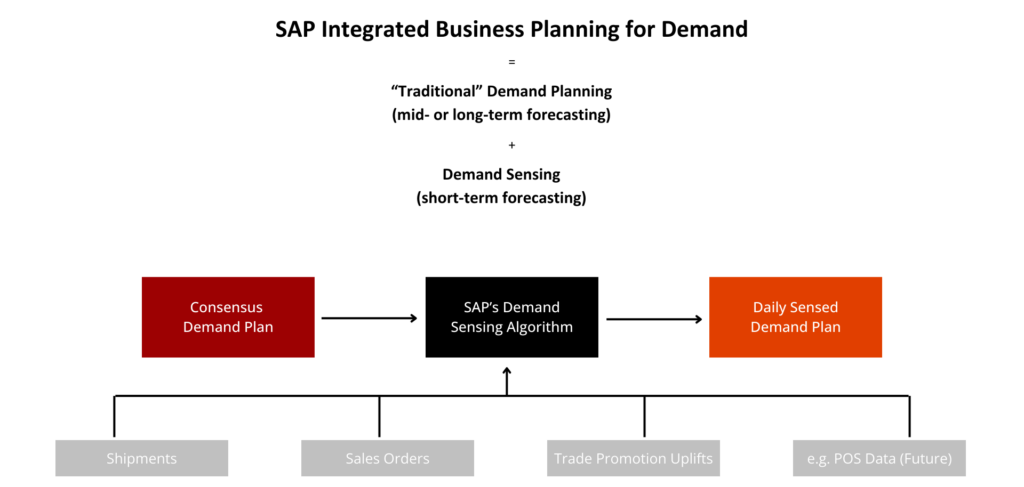SAP Integrated Business Planning (IBP) – Demand Sensing

Introduction
Are you struggling to achieve accurate forecasts in your demand sensing process?
Do you want to optimize inventory levels and meet customer demand effectively?
Then, look no further than SAP Integrated Business Planning (IBP).
Traditional forecasting methods, such as statistical forecasting, have been effective in providing insights based on historical sales data. However, they often fall short in capturing real-time market dynamics and responding to unpredictable events. In this blog, we will explore the concept of demand sensing, its benefits, and how SAP IBP is revolutionizing the way businesses forecast their demand.
What is Demand Sensing?

Demand Sensing is a forecasting method that utilizes artificial intelligence and real-time data capture to generate demand forecasts based on the current realities of the supply chain. Unlike traditional forecasting techniques that rely on historical sales data, it incorporates a broader range of demand signals, including current data from the supply chain, market shifts, weather changes, natural disasters, and changes in consumer buying behavior. This enables organizations to adapt their forecasts quickly and accurately to changing market conditions.

Benefits of Demand Sensing
- Bridging the Gap between Planning and Execution
Captures real-time demand, refining forecasts by integrating daily data signals. This reduces safety stock, speeds up order fulfillment, and boosts customer satisfaction while cutting costs.
- Enhanced Responsiveness to Market Shifts
In volatile markets, demand Sensing swiftly adjusts production and transportation plans based on current data, ensuring businesses meet dynamic customer requirements, leading to improved satisfaction and cost efficiency.
- Improved Collaboration and Consensus Planning
Demand sensing involves multiple stakeholders, including sales, marketing, regional teams, and global teams. This collaborative approach ensures that all relevant inputs and insights are considered during the forecasting process.
- Optimizing Inventory Planning and Deployment
With daily demand insights, optimizes inventory planning, aligning levels with specific days and considering non-working days. It enables informed decisions on production and procurement by matching demand forecasts with open orders.
- Artificial Intelligence and Demand Signals
Demand Sensing leverages artificial intelligence and demand signals to enhance the accuracy of demand forecasting. In SAP Integrated Business Planning for Supply Chain, organizations can utilize multivariate forecasting algorithms such as Gradient Boosting of Decision Trees, (Seasonal) ARIMAX, and Multiple Linear Regression for long- and mid-term forecasts.
Demand Sensing in SAP IBP vs. Statistical Forecasting
While Demand Sensing is a powerful tool for enhancing demand forecasting, it is important to understand its differences from statistical forecasting in SAP IBP. Statistical forecasting also leverages artificial intelligence and demand signals to generate forecasts. The key distinction lies in the time horizons and forecast levels each method is most suitable for.
- Time Horizons and Forecast Levels
Statistical forecasting can be forecasted at any time level. However, it is important to note that not all forecast levels are equally accurate. For instance, a monthly forecast may show seasonality patterns more clearly than a weekly forecast. As a result, using statistical forecasting for daily forecasts, which often exhibit intermittent demand and noise, may not yield optimal results.
In contrast, SAP IBP is specifically designed for accurate daily forecasts. After optimizing the weekly forecast, it intelligently disaggregates the forecast to days by analyzing patterns from the past few weeks. This analysis considers workdays, holidays, and open orders, resulting in more precise daily demand forecasts.
- Data Considerations
Another difference between statistical forecasting and SAP IBP is the utilization of current data. Current data is only available for the recent past and present, making it more relevant for short-term forecasts. It enables organizations to incorporate current data signals that are only available in the past horizon. By automatically understanding the lag between the signal and its effect on sales, enhances forecast accuracy
SAP Integrated Business Planning Features for Demand Planning
SAP IBP offers a comprehensive platform tailored for demand planning. Let’s take a closer look at some key features that make it a powerful tool for businesses seeking to optimize their demand planning process:
- Demand Sensing: Real-time Visibility into Demand Fluctuations
One of the standout features is demand sensing. By providing real-time visibility into demand fluctuations, businesses can promptly adjust their strategies to meet changing customer needs.
Demand sensing leverages powerful algorithms to analyze a wide range of signals, including current data from the supply chain, market shifts, weather changes, and consumer buying behavior. This enables businesses to create a more accurate forecast that responds to real-world events, ultimately improving forecast accuracy and profitability.
- Machine Learning and Statistical Models for Accurate Forecasts
SAP IBP incorporates machine learning and statistical models to generate accurate forecasts. These advanced technologies analyze historical sales data, identify patterns, and consider external factors like economic indicators and market trends. Businesses can generate forecasts that are more accurate and reliable, enabling them to make informed decisions regarding production planning, inventory management, and resource allocation.
- Integration with Existing Supply Chain Management Systems
Seamless integration with existing supply chain management systems is another significant advantage of SAP IBP. By eliminating data silos and ensuring a smooth flow of information, it streamlines the demand planning process. This integration allows businesses to access real-time data, collaborate more efficiently, and reduce redundancies and errors.
- Short-Term Forecasting with Demand Sensing
While traditional demand planning focuses on mid to long-term forecasting, SAP IBP’s demand sensing algorithm is designed to generate accurate short-term forecasts. By considering multiple inputs and advanced mathematical techniques, demand sensing provides businesses with a more accurate forecast for the next 4-8 weeks (about 2 months).
This enables businesses to adjust their production and transport plans promptly, ensuring that inventory levels are aligned with short-term demand requirements.
Many organizations have witnessed significant improvements in their demand planning process after implementing SAP IBP. Let’s explore some real-life case studies that highlight the success of SAP IBP in enhancing forecast accuracy and optimizing inventory levels:
Successful Implementation of SAP IBP for Demand Planning
Case Study 1: Leading Electronics Manufacturer
A leading electronics manufacturer successfully implemented SAP IBP for demand sensing and experienced a 20% improvement in forecast accuracy within a year. This improvement not only led to increased customer satisfaction but also optimized inventory levels, resulting in significant cost savings. With it’s advanced technologies and collaborative input, the manufacturer was able to meet market demands effectively and make data-driven decisions.
Case Study 2: Global Retail Chain
A global retail chain faced challenges in accurately predicting demand due to volatile markets and demand shifts. After implementing this solution, the retail chain witnessed a remarkable reduction in forecast errors across the demand sensing horizon. The accuracy of the weekly consensus demand forecast also improved significantly. By incorporating demand sensing into their planning processes, the retail chain was able to align their production and transport plans with short-term demand requirements, ensuring efficient inventory management.
Conclusion
SAP Integrated Business Planning (IBP) stands as a transformative force in demand planning, offering businesses a strategic edge through advanced technologies and collaborative functionalities. With its ability to enhance forecast accuracy, optimize inventory levels, and streamline demand planning processes, it empowers organizations to effectively meet customer demands and proactively navigate market dynamics. Considering the potential benefits, choosing to implement SAP IBP could be pivotal in attaining operational excellence and success in demand planning.
For guidance and expert assistance, KaarTech is your partner in efficient demand sensing. Free to contact us, we would be happy to assist you!
FAQ’s
What is Demand Sensing?
Demand Sensing is a real-time forecasting method in SAP IBP that uses AI and current data to generate accurate demand forecasts, adapting quickly to supply chain dynamics.
What are the Benefits of Demand Sensing?
Demand Sensing bridges planning and execution gaps, enhances responsiveness to market shifts, fosters collaboration, and optimizes inventory planning, resulting in improved customer satisfaction and cost efficiency.
Difference between Demand Sensing in SAP IBP vs. Statistical Forecasting?
While both use AI and demand signals, SAP IBP’s Demand Sensing excels in daily forecasts, intelligently disaggregating weekly forecasts for more precise daily demand predictions, compared to statistical forecasting’s broader time horizons.
What are the Features of SAP IBP?
SAP IBP features demand sensing for real-time visibility, employs machine learning and statistical models for accurate forecasts, integrates seamlessly with existing systems, and specializes in short-term forecasting (4-8 weeks). The platform enhances collaboration and consensus planning for effective demand planning.
